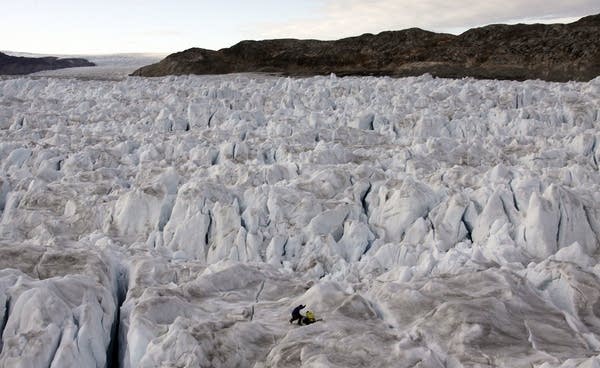Freak May snowstorm is weather, not climate
Go Deeper.
Create an account or log in to save stories.
Like this?
Thanks for liking this story! We have added it to a list of your favorite stories.

The bizarre storm that dumped heavy snow in nearby suburbs but left nothing on the ground in downtown St. Paul has possible connections to climate change, says Paul Huttner. But he stops short of drawing conclusions from a single event.
In a conversation with The Daily Circuit's Kerri Miller, Huttner said the storm might be connected to the "Arctic amplification" effect that he's discussed on the show before. The disappearance of Arctic sea ice seems to be affecting the jet stream, which in turn has contributed to Minnesota's seemingly endless winter.
Here's an edited transcript of their conversation:
Miller: I think this late spring snow is a good opportunity to ask again as we have during our Climate Cast — weather or climate? How do we answer that?
Turn Up Your Support
MPR News helps you turn down the noise and build shared understanding. Turn up your support for this public resource and keep trusted journalism accessible to all.
Huttner: What's happening today is weather, there's no doubt about it. This is a very out of season event. All weather in a way seems to be colored or flavored by the climate changes we're seeing. If you're going to tie a link to today's weather to climate change you would have to cite Arctic amplification. We've touched on that before. That's where this slower jet stream gets stuck. It slows down and these blocking patterns set up and our weather patterns get stuck. That's what's been happening a lot in Minnesota and the Upper Midwest this spring. Some links that this may be tied to the warmer Arctic Ocean that we saw last summer. It's not a slam dunk, but the clues all seem to be pointing in the same direction.

Miller: I got into a conversation with some people from Denver where I was traveling and they've had a very similar winter as we've had and they were getting this late spring snow. When you're talking about the jet stream and the weird way it's behaving, is it people above one area of the jet stream are having this kind of weather and people below it are having a different kind of weather? Or is that too simple?
Huttner: That's right in a big sense. The other part of that is these waves in the atmosphere, these cold pools if you will, they tend to cover about half or two-thirds of a continent and the way it's set up over North America it's really run from the Great Lakes back into the northern Rockies and down, including the Denver area. Those are the areas that have been cool and unusually snowy this spring.
We've had three consecutive months colder than average in the Twin Cities. We had our third snowiest April. We can't see the whole earth from our living room window or backyard. That's why we call it global climate change. In the same year that we're so cold here and in Eurasia, it is the eighth warmest year on record so far globally. It's warm on the rest of the planet. It's cold in the U.S., Canada and Eurasia. It's warm in Greenland where these big blocks are setting up. It's warm near the equator, it's warm in Africa and much of the southern hemisphere. What's happening locally in a sense is weather, but globally the climate, even though it's chilly here, it's still the eight warmest year on record so far globally.
Miller: I remember you saying when we've talked about the character of the storms that might be being influenced by climate change, they tend to hold more moisture and they're going to be more intense. Did we see an indication of that in this storm? Because it's wet, heavy snow.
Huttner: Indeed it is. Again, it's one storm so it's hard to make that call on one specific event. We're seeing a trend where the atmosphere overall holds about four to five percent more water vapor than it did a decade ago, and that injects these storms with more moisture.
The other thing about this storm and drawing a parallel with Hurricane Sandy late last fall, it's a little bit out of season. In fact, this is well out of season for Minnesota. It's unprecedented, the amount of snowfall we've had today in Minnesota. Mark Seeley tells me that Dodge Center, with 15.4 inches of snow, broke the all-time state snowfall record for May 2 today. This is definitely an unprecedented out-of-season event. When you get these events in May, when we've still got cold enough air for snow but we've got so much warmth and moisture to the south, it just supercharges these storms and that can tend to produce more precipitation than an atmosphere with less water in it.
Miller: When I traveled at the end of the year, we went to Patagonia. You go out in a boat on a huge lake and you can get right up next to some of the remaining glaciers in the world. What the guide told us is that while they're often retreating, that retreat is accelerating and we're seeing that in some new research out about glaciers.
Huttner: This study came from The Cryosphere. What it's looking at are these high-altitude tropical glaciers in the Andes Mountains. Many climate scientists look at this as a canary in a coal mine for climate change. These Andes glaciers have shrunk 30 to 50 percent in the past 30 years and this is important because these high altitude glaciers are among the most sensitive indicators of climate change.
If you get these high temperatures higher up in the atmosphere, that means the higher atmosphere is warming up around 25,000 feet. That's a huge indicator that the whole globe's atmosphere is warming even four to five miles up. That can't be attributed to urban heat island or anything else. When we start losing the high altitude tropical glaciers, that's a big indicator that the overall atmosphere is warming.
Miller: And that's going to have an impact on the climate around it.
Huttner: In fact, there are feedback mechanisms that work with these things and the Pacific Ocean might be playing a role with this as well. One of the interesting people working on this is Mathais Vuille, associate professor in the department of atmospheric sciences at SUNY-Albany. He's a climate scientist who works on the interaction between climate and glaciers, mainly in the tropics.
Vuille (on tape): You can think of glaciers like sort of a bank account. They advance or retreat when they aren't in equilibrium. That means either there is more or less snow falling on top of the glaciers than is melting at the bottom. You can have a change in the amount of snow that is falling and it can get very dry so your glacier will retreat. Or it could get much warmer and then your glacier will also retreat.
What we know from observations looking at climate records throughout the Andes, there is no sign that says the climate has been getting drier everywhere. It has in some regions but in other regions it actually has been getting wetter and we have more snowfall, yet the glaciers have been retreating there as well. The only explanation we have really is that glaciers are responding to an increase in temperatures and that's something we are actually seeing everywhere. We know that temperatures have gone up.
Miller: What does this tell us about what's happening in the water?
Huttner: There are a couple of things here. One of them is that everything is heating up at that elevation. It stems back to these warmer Pacific Ocean temperatures. Which may be producing more rain at these high elevations, around 17,000 feet, instead of snow. So instead of feeding the glacier with more snow you're actually washing it away with high altitude rains instead of snow.
The other thing they're seeing is at 17,000 feet in the Andes, they're already seeing 80 to 100 percent glacial melt. Some of these glaciers will be gone in the next 10-15 years. There's a famous glacier above La Paz, Bolivia, that has melted and just disappeared in 2010. Climate scientists looking at this are saying if these high altitude glaciers are melting and they're in the tropics then we know the atmosphere is warming at a very high level and that's something they can keep an eye on.
Miller: Although we are having a chilly, wet spring, it is very warm in other parts of the world, including Greenland. That's a place where they monitor the permafrost very carefully.

Huttner: Greenland is literally crawling with climate scientists who have been drilling ice cores and have observing stations in all different areas. Last summer was unprecedented. It was the first time the high-level interior of Greenland, it sits up around 12,000 feet, even at that elevation, there was melt last July for the first time on record. The rate of melt is remarkably fast.
Greenland is a different animal because those ice sheets don't sit on the ocean. As they melt and rush into the ocean, that has an effect on sea level. Some estimates are that sea level could rise as much as 20 feet if all of Greenland melted.
What you're hitting on is this picture of climate change is not being painted in one region. It's being painted around the globe. In Greenland, in Antarctica, in the high mountains of the Andes, in Minnesota and the changes we're seeing here, in the desert Southwest. You put it all together, it all points in the same direction. Our climate is changing quickly and it's changing faster than a lot of people modeled and thought it would over the last decade or so.
Miller: Which is why there is urgency around some kind of global policy on climate change. We know the leaders of many countries come together every couple of years to try to reach some kind of policy, and yet not much progress has been made because so many different people come to the table with so many different interests.
Huttner: There are many, many interests including China, which is industrializing at a rapid rate. They're building 33 new coal-fired power plants. And yet interestingly China is taking a lead on climate change. New studies coming out there saying they're pinpointing links to local emissions and local climate change in China. The political part of this is a very complex mosaic, but the science all points in the same direction.



